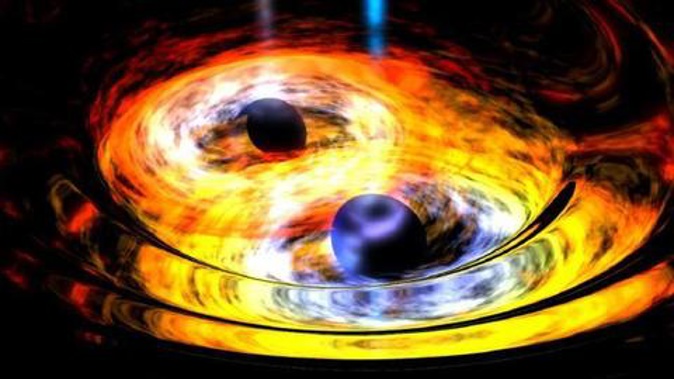
Einstein's greatest prediction may have been correct: The titanic forces unleashed by two colliding black holes has reportedly exposed the fabric of space-time itself through long-elusive gravitational waves.
The physics community has been abuzz with speculation ever since excited researchers affiliated with - but not directly involved in - the project spilt the beans on Twitter.
The US National Science Foundation and the Laser Interferometer Gravitational-Wave Observatory experiment (LIGO) has now announced a press conference for 10.30am ET Thursday (2.30am AEDT Friday) in Washington DC to coincide the publication of a report in the science journal Nature. The event will be broadcast live.
The international collaboration includes researchers from Australian National University, Monash University, The University of Melbourne, University of Adelaide and University of Western Australia.
So what's the fuss?
Failing to find them would mean a return to the drawing board: Our fundamental understanding of how the universe operates would be wrong.
Einstein's famous Theory of General Relativity turned our understanding of space and time on its head. He argued that neither is fixed. Instead, they are dependent upon each other - and the state of one changes with the condition of the other.
Space and time for a single object sitting stationary remains static. But put two objects together, and the matter and energy within them interacts to distort space-time - causing the objects to accelerate and spiral towards each other.
This acceleration emits gravitational waves.
Einstein predicted their existence a few months more than a century ago.
But such gravitational waves have been, until now, both theoretical and imperceptible.
Their behaviour is thought to be similar to that of light and radio waves, except that interact with space and time itself. They 'warp' the very fabric of the universe - shrinking and expanding the distance between two points in the same way a flag billows in the wind.
But gravity is also the weakest force. Gravitational waves cause such a tiny wiggle in space-time that Einstein thought they would never be detected.
We've not had much luck finding them.
Einstein inferred the energy of an exploding star - a supernova - would be dissipated by relatively huge gravitational waves rushing outward at the speed of light.
He also calculated that two immensely dense neutron stars orbiting each other very closely would also ripple-out immense energy as gravitational waves.
But Einstein told us where to look.
But it has long appeared that his idea that the titanic fallout from the collision of two black holes would blast across the cosmos like a rock crashing into a still pond was the most likely to bare fruit.
So what's the problem with seeing gravitational waves produced by such a colossal collision?
On an intergalactic scale, even the incomprehensible energy of colliding black holes translates to the barest vibration of atoms inside our bodies - or a flutter of photons between two lasers.
One of the most advanced (and expensive) efforts to catch gravitational waves in the act began in 2002: The Laser Interferometer Gravitational-Wave Observatory (LIGO). As the complicated name infers, this experiment has been attempting to measure the infinitesimal vibration of perpendicular laser beams reflected along a 4km vacuum tube in a tunnel.
Two such enormous L-shaped tunnels are positioned some 3000km apart - one on either side of the United States.
The theory goes that any true gravitational wave would cause a ripple in the lasers at both locations. Any nearby slamming doors would therefore be cancelled out.
For more than eight years, the sensor didn't spot anything.
Late last year, however, a major upgrade which began in 2010 was completed.
Its operators believe this laser system should be sensitive enough to detect the gravitational waves generated by two black holes (somewhere between the mass of 1 and several hundred Suns) crashing into each other should be detectable in a radius of 225 million light-years.
Odds are, over such an immense distance, such a collision would occur a couple of times each year.
Such an event would produce a distortion in the pattern cast by these lasers equivalent to a fraction of the width of a single proton in the nucleus of an atom.
It may have already happened.
Rumours of the discovery leaked via Twitter claim the gravitational wave detected was consistent with the clash of two black holes of 36 and 29 times the mass of the Sun. The new - bloate - black hole that came out of the merger appears to weigh in at 62 solar masses.
But, if true, we won't know where - or when - this event happened.
To gain the sort of resolution needed to pinpoint the part of the sky such a wave came from would require many more of these 4km-long laser-vacuum pits.
But plans are already afoot to increase the equipment's sensitivity much further - enabling it to detect gravitational wave sources from more than 650 million light years away.
Take your Radio, Podcasts and Music with you









